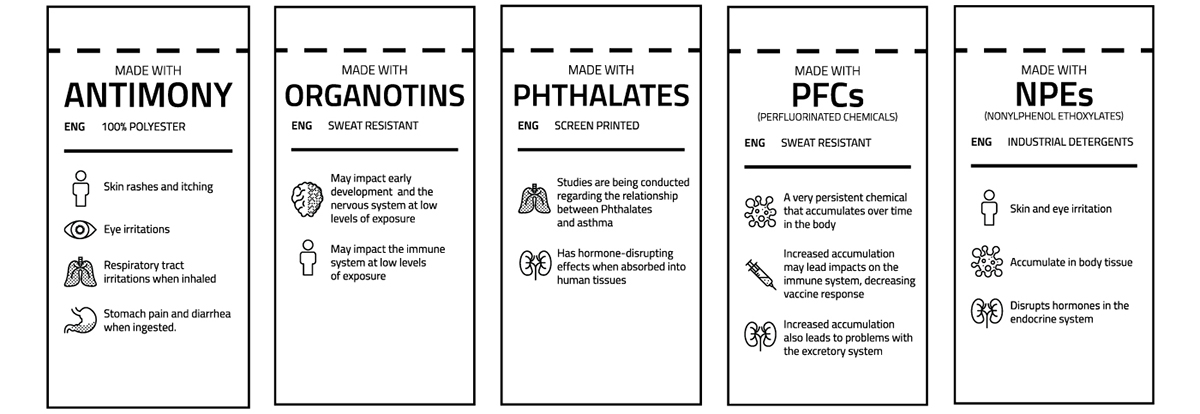
Problem.
Away from the prying eyes of the public lies a city of garment factories, using gallons of chemicals to manufacture our everyday clothing. These chemicals, absent in the contents of the clothing labels, are often overlooked or ignored by parents due to said reason. And there lies the danger; these chemicals are harming children's health without their knowledge.
Target Audience.
When exposed to children, the risk of getting affected increases tenfold, primarily due to the young ones' developing immune system. It is therefore the aim of this project to expose these chemicals to parents, the target audience, as well as educate them on measures to avoid these invisible fiends.
Scope Of Exploration.
This is a school project. The research content from this project are credited to the Little Monsters campaign from Greenpeace.
This project delves into five main chemicals potent in children's clothing; Antimony, Phthalates, Organotins, PFCs (Per- and poly- fluorinated chemicals), and NPEs (Nonylphenol ethoxylates/ Nonylphenols). Each chemical has different properties and appears in different types of fabric. In order for parents to be educated, they must first be aware of these chemicals. The creative concept below explains how this project intends to clearly expose their dangers.
Creative Concept.


Execution.
1. Hockney's Joiner (ref.) is a photography style that consists of several images pieced together to form one big image. This allows us to experiment with different fabric materials for each piece and have one big canvas consisting of a variety of fabrics. The fabrics used are standard cloth used in garments that contain these chemicals.
The photograph will be that of a young child, wearing different articles of clothing. Various close-ups of the model are taken and subsequently pieced together (shown below). Different clothing are worn to show the variety of clothes a child will wear throughout the day, as these chemicals may be equally potent in all of them.


2. Light Paintings of the harmful effects of the chemicals are superimposed onto the final piece, looking like an "X-Ray" of the body, revealing what the naked eye couldn't see. They are in a glaring red, some illustrating internal organs, and others illustrating skin irritations; all of which are caused by these chemicals.

3. Image Transfers are used to transfer the printed Hockney's Joiner piece onto the fabrics. These fabrics were gathered from various clothing stores, and vary in material. Each material corresponds to the chemical that is found inside. This allows parents to touch and feel the different dangerous fabrics that they might've exposed their children to.

4. Darning is a technique of hand-embroidery used to mend holes (damage) in fabric. Just like how these chemicals are "polluting" the fabric, stitches are darned onto the canvas to show the presence of damage done by the chemicals.
The colour of the stitches darned correspond to the colours of the spot they're on, as if camouflaging into the fabric itself, since the chemicals are so well-hidden from the public.

5. Custom Labels for each chemical are made, resembling standard clothing labels on garments in store, since the chemicals don't appear in the contents of the latter. These custom labels contain information about the chemicals, and the necessary measures parents should take to stop them. They are sewn on to the fabric canvas like standard labels.
Below are the custom labels, four for each of the five chemicals. They give information on the fabric they're found in, health effects on the children's body, safer alternatives to look for, and a QR code to link to Greenpeace's report, where we got all this information from, as a form of credibility.





Final Piece.




Project Synopsis.
Once upon a time, harmful chemicals were unsuspectingly aplenty in the clothing of vulnerable children. This project, Fuzzy Fiends, uncovers these chemicals by putting their clothes onto canvas. Pieced together by a bounty of different fabrics and image transfers akin to the toxic garments in store, the chemicals are hand-stitched and blended into the canvas' colour, portraying a parallel to how they are camouflaged in actual children's clothes. The effects of these chemicals are exposed red-handed with light painting, and are aptly tagged with their own clothing labels, warning cautious parents to cease purchasing them for a detoxified fashion-forward future.

The final piece consists of five sections, one for each chemical. The materials and image transfer methods used in the pieces from that section correspond to the chemicals they represent.
Materials Used
Antimony: Polyester (Antimony is used in the manufacture of polyester)
NPEs: Fabric from H&M (one of the listed brands that were tested to use NPEs as an industrial detergent
Organotins: Cotton socks (Organotins are found in sports clothing, shoes, and socks)
PFCs: Various fabrics sprayed with a waterproof spray containing PFCs, PVC
PFCs: Various fabrics sprayed with a waterproof spray containing PFCs, PVC
Phthalates: Various fabrics with images transferred via heat transfers (Phthalates are found in heat transferred prints)
Icons used for this project are made by madebyoliver (http://www.flaticon.com/authors/madebyoliver)
Case Film.





